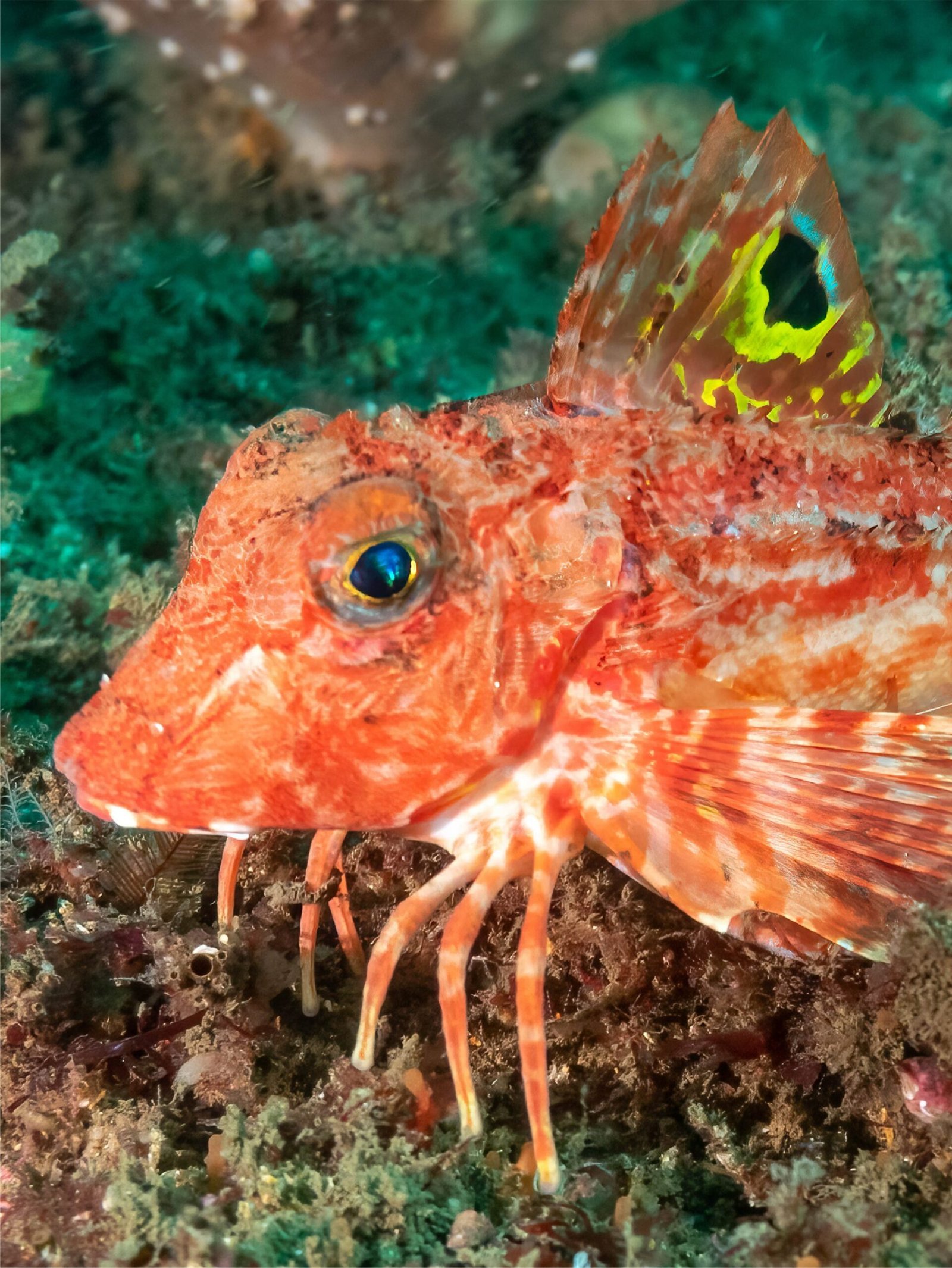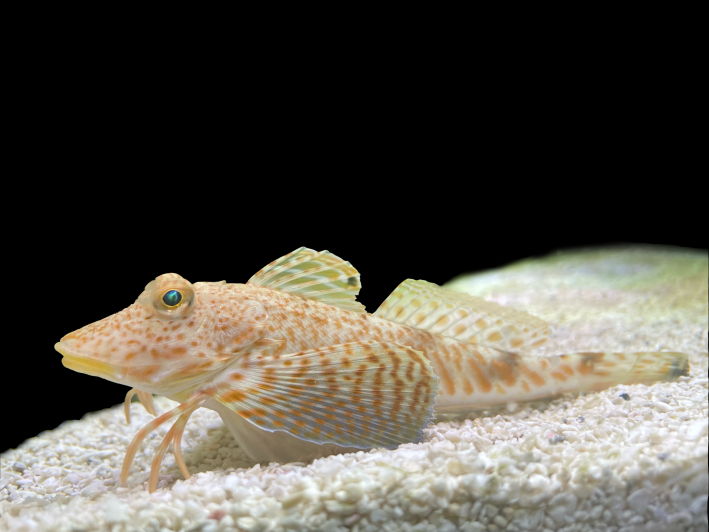
The sea robin begins its life looking like any other fish: a finned, larval speck drifting in the open ocean. As the sea robin grows, the pectoral fins on either side of its body widen like two unfurling fans—still fins, if a bit extravagant. But eventually the first three rays of each fin separate. They lose their webbing, tapering into slender structures that look remarkably like legs. When adult sea robins settle on the seafloor, where they will spend the rest of their lives, they use these “legs” to walk, stilt-like, the rest of their body hovering a few inches above the sand.
Corey Allard, a cell biologist and electrophysiologist at Harvard University, knew sea robins as the fish his dad and brothers frequently reeled in from the Atlantic. But he did not realize they had legs until he saw them at the Marine Biological Laboratory in Woods Hole, Mass. “Never looked that closely, I guess, nor expected a fish to have legs like that,” Allard said.
Sea robins have a certain reputation among the fishing community, as people believed the fish were able to find buried prey. After group of researchers decided to test this ability in a lab, they discovered certain sea robins use their legs not only to walk and dig in the sand, but also to taste for prey. This discovery led to a sprawling project investigating the genetic origin and development of the sea robins’ strange legs and examining the fish as a model to understand the larger evolutionary question of how an animal makes a totally new organ. Their work is published today in two papers in Current Biology, one focused on sensory biology and the other on genetics.
Brett Aiello, a neurobiologist at Seton Hill University who was not involved with the research, was pleased to learn that the fish’s legs could taste. “That’s wicked cool in itself,” he said. But he said he found the study’s scope—which investigates the sea robin’s legs on molecular, morphological, and behavioral levels—extraordinary. “We’re hitting so many different levels of biological organization in this study, and I think that’s what’s truly special and amazing about what the authors did,” he said.
Nicholas Bellono, a physiologist at Harvard University and an author on both studies, has always been interested in animals with unconventional adaptations. About five or six years ago, Bellono swung by the Marine Biological Laboratory in Woods Hole to pick up some squid for ongoing research on how the cephalopods sense with their arms. Scott Bennett, a manager at the lab and an author on the paper, pulled Bellono aside and said he needed to show him a weird fish with something even weirder going on: “the legs they’re crawling around on,” Bellono said. When Bennett mentioned the fishers’ lore about another purpose for the fish’s legs, Bellono decided to take some fish back and see for himself.
The researchers started with “silly experiments,” Allard said, putting the sea robins in tanks with some food buried in the sand, either a mussel, a capsule of mussel extract, or a capsule of a single amino acid found in the fish’s prey. The sea robins swam and walked around the tank, occasionally scratched at sand with their legs, and regularly dug up the buried food. “We found that they were really good at finding the buried items, and they could do it even to one molecule buried in the capsule,” Bellono said. But when the researchers attempted to track down the sea robin’s sensory receptors, they had no idea where to look—the head or the legs?
As the experiments got serious, the researchers went back to pick up more sea robins. But these new sea robins could not dig in the sand, let alone find the buried prey. “I thought probably we had messed up, or the fish were sick or something,” Bellono said. But when the researchers looked closer, they noticed the legs of the original fish, which were northern sea robins, were shaped like shovels with small sensory papillae that knobbled the legs like a blackberry. The new species, striped sea robins, had smooth, stick-like legs with no papillae.
This discovery broke open the research. Allard combed through specimens of other sea robin species from museums, and found that only a small group of species closely related to the northern sea robins had leg papillae, while the majority of sea robins had the stick-like legs, suggesting the northern sea robins’ ability to dig and taste with their legs was a relatively recent evolutionary adaptation.
As the researchers looked closer, they noticed the northern sea robins only had papillae on the bottom half of their legs. “Imagine they’re like, below the knees,” Allard said. “If you can imagine the fish having knees.” This part of the leg was sensitive to touch and taste, but the fish did not have traditional taste buds, which are long, spindly cells. Instead, the sea robin’s taste receptors were located in small, epithelial cells that resemble ordinary skin cells. “It used the same taste receptors we do to taste, but it repurposed them in this new cell type, new place, and in new combinations,” Bellono said.
This would present a challenge to the fish’s brain to process this information, raising questions for the researchers about how the brain has evolved to integrate the new organ. “It’s like if all of a sudden you can taste through your fingers,” Allard said. “It might be confusing to you at first, to make sense of your world that way.” Some other ray-finned fish have taste buds outside their mouths: catfish have taste buds all over their body, and some damselfish can taste with papillae-like taste buds on their pelvic fins, Aiello said. “You can get new traits from existing machinery if you just tinker with it a little bit,” Bellono said.

In the second paper, led by the Stanford biologists Amy Herbert and David Kingsley, the researchers investigated the genetic underpinnings of these digging, tasting legs, in part by hybridizing the two species and tracing which offspring inherited which legs. They located an ancient gene, tbx3a, that controls the development of limbs, and found it also drives the tasting, digging specialization of the fish’s legs.
Allard’s father has always thought it was funny that his son started researching a fish that he caught for years, never thinking it would be of scientific interest. “He actually knew probably more than I did when we started the project about them,” Allard said of his dad. Allard found that putting fishers’ stories of an understudied and unusual creature like a sea robin to rigorous scientific tests in the lab was challenging but extremely useful—a reminder that important discoveries can come from people who are willing to follow their curiosity, even if these projects are less likely to generate funding.
“It can be hard to convince someone that that it’s worth doing this type of work, that studying a fish with legs is actually going to tell us something that’s that’s worth the effort and and the investment,” he said. But this, Bellono said, is at the heart of his personal philosophy of science: “noticing this really curious animal that’s bizarre, and asking, ‘how does it do that?'” All it takes is one weird fish.








